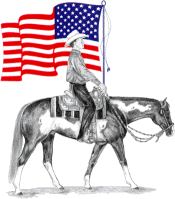|
BACKGROUND:
Llamas are members of the camel (camelid) family. The camelids originated on the central plains of
North America about 40 million years ago. From there, about three million years ago, llama-like animals dispersed to South
America. By the end of the last ice age (10,000-12,000 years ago) the camelids were extinct in North America. Llamas were
domesticated from guanacos in the Andean highlands of Peru 4,000-5,000 years ago, and are among the oldest domestic animals
in the world. Primarily a beast of burden, they also provide native herdsmen with meat, wool for clothing, hide for shelter,
manure pellets for fuel, and offerings to their Gods. Today there are an estimated 7 million llamas and alpacas (in approximately
equal numbers) in South America, and only a little over 100,000 llamas in the United States and Canada. PHYSICAL FACTS:
LIFE SPAN:
About 20-25 years
WEIGHT:
280 to 450 pounds
BIRTH:
A single baby call a cria (cree-ah) is normally delivered without
assistance from a standing mother
during daylight hours. Twin births
are rare. Average gestation is 350 days.
BABIES:
Birth weight is 20-35 pounds. Babies are normally up and nursing
within 90 minutes. They are usually weaned at 4-6
months.
REPRODUCTION:
Females are first bred
at 20-24 months depending on maturity and
weight. Llamas do not have a heat cycle, but are copulation induced
ovulators.
Ovulation occurs 24-36 hours after breeding. Thus they
can be bred at any time of the year.
WOOL:
Llama's wool ranges in various colors frrom white to black, shades of
gray, beige, brown, red and roan. The coat
may be solid, spotted, or
marked in a variety of patterns. The llama's fleece also varies
between short, medium,
and heavy wool.
HEALTH:
Because llamas and
their ancestors are specially suited to the harsh
environment of their Andean homeland, North American owners will
find
them remarkably healthy, easy to care for, economical to keep,
and remarkably disease-free. FREQUENTLY ASKED QUESTIONS:
What Are They Used For?
Uses
include pets, breeding stock, pack animals, driving animals, guard animals,
wool production, showing, 4-H programs, and
as relaxing therapy for humans.
Are They Intelligent?
Llamas are very intelligent and easy to train. In just a few repetitions they will
pick up and retain many behaviors
such as accepting a halter, being led, loading
in and out of a vehicle, pulling a cart, and carrying
a pack.
What Is Their Personality Like?
These
highly social animals need the companionship of their species.
Independent, yet shy, llamas are gentle and curious. Their
calm nature and
common sense make them easy for anyone, even children, to handle.
What And How Much Do They Eat?
Llamas are a modified ruminant
with a three-compartment stomach. They chew
their cud like cattle or sheep. Because of a relatively low protein requirement
due
to their efficient digestive systems, they can be kept on a variety of pastures and hay.
Are They Good Pack Animals?
Llamas make excellent pack
animals. They can carry 50-125 pounds, but are not
ridden except by children. Their two-toed foot with its leathery bottom
pad gives
them great sure-footedness. This foot, and the llamas "cafeteria" style browsing
habit,
give the llama an impact on the environment equal to a large deer.
What Sound Do They Make?
Llamas communicate with a series of ear, body and tail postures, as well as soft
humming sounds. They
also have a shrill alarm call alerting to danger.
Can You Use Their Wool?
Grease-free, lightweight llamas wool is warm, luxurious and popular with
spinners, weavers, and felters.
Do They Spit?
Llamas do not normally spit at humans. Spitting
is the llamas way of saying
"Bug-Off!" Spitting is usually used only among llamas to divert annoying suitors,
ward off a perceived threat, or to establish a pecking order at mealtime. An occasional llama who has been forced to tolerate
excessive human handling may
develop an intolerance or fear of humans, and will spit if he feels
threatened.

THANK YOU FOR CHECKING OUT OUR SITE. HAVE A NICE DAY !
|

